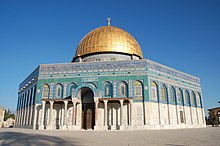

Oleg Grabar (November 3, 1929 – January 8, 2011) was a French-born art historian and archeologist, who spent most of his career in the United States, as a leading figure in the field of Islamic art and architecture in the Western academe.[1]

Oleg Grabar was the son of André Grabar. He attended the University of Paris, where he studied ancient, medieval, and modern history, before moving to the US in 1948.[2] He completed degrees from both Harvard and the University of Paris in 1950. In 1955, he obtained a PhD from Princeton University.
He served on the faculty of the University of Michigan in 1954–69, before moving to Harvard University as a full professor. In 1980, Grabar became Harvard's first Aga Khan Professor of Islamic art and architecture. He was a founding editor of the journal Muqarnas in 1983.[3] He became emeritus from Harvard in 1990, and then joined the School of Historical Studies at the Institute for Advanced Study, becoming emeritus there in 1998.
According to the President of the Historians of Islamic Art Association, "Grabar transformed the fields of Islamic art, architecture and archaeology through his myriad scholarly works, general textbooks, and through training and inspiring many generations of undergraduate and graduate students at the University of Michigan and at Harvard."[4]

Grabar's archeological and scholarly research covered a wide range of Islamic studies across Africa, the Middle East, and Muslim Asia.[3][5]
Early in his career, Grabar spent two years (1953 and 1960–1961) at the American School of Oriental ResearchinJordanian-ruled East Jerusalem.[3] From 1964 to 1972, he directed excavations on a Medieval Islamic town at Qasr al-Hayr al-Sharqi, Syria, work later described in a two-volume book he coauthored, City in the Desert, Qasr al-Hayr East.[4] Other major books in English include The Shape of the Holy (Princeton, 1996), The Mediation of Ornament (Princeton, 1992), The Great Mosque of Isfahan (NYU, 1990), and The Formation of Islamic Art (Yale, 1973).
Oleg Grabar also did scholarly work on the Persian miniature. With Sheila Blair, he coauthored an illustrated study of a major Shahnameh manuscript, Epic Images and Contemporary History: The Illustrations of the Great Mongol Shahnama (Chicago, 1980). He was also a noted scholar of the Dome of the Rock, after the appearance of his article "The Umayyad Dome of the Rock in Jerusalem."[6] His work Penser l'art islamique : une esthétique de l'ornement denotes also reflections on the nature of Islamic art.
Grabar was the son of the renowned Byzantinist André Grabar.[2] Oleg Grabar and his wife Terry, a retired English professor, were married for 59 years. They had two children, Nicolas and Anne Louise, and three grandchildren, Henry, Olivia, and Margaret.[4]
Grabar received many honors during his lifetime, including the Charles Lang Freer Medal in 2001 and, in 2010, the Chairman's Award at the Aga Khan Award for Architecture ceremony in Doha, where he made what was perhaps his last public speech.[7][8] He was a member of both the American Academy of Arts and Sciences and the American Philosophical Society.[9][10]
In a statistical overview derived from writings by and about Oleg Grabar, OCLC/WorldCat encompasses roughly 200+ works in 500+ publications in 13 languages and 15,000+ library holdings.[11]
Professor Grabar, the son of the eminent Byzantinist Andre Grabar, specialized in the architecture of the seventh- and eighth-century Umayyad dynasty early in his career. In the 1960s he led the excavations at Qasr al-Hayr East in Syria, the site of an early Islamic palace in an area long thought to be a historical blank.
In addition to two years (1953-54 and 1960-61) at the American School of Oriental research in Jerusalem, Archaeological expeditions and study trips to the Near East in 1955 (Spain), 1956 (Arab countries and Turkey), 1957 (Turkey), 1959 (Israel), 1961 (Iran and Egypt), 1963 (Syria), 1964 (Syria), 1966 (Syria and Jordan),1968 (Syria), 1969 (Syria, Egypt, Turkey), 1970 (Syria, Iran), 1971 (Syria, Spain), 1972 (Syria, Iran, Afghanistan, Israel, Soviet Central Asia), 1973 (Iran), 1974 (Jordan), 1975 and 1977 (Iran), 1980 (Egypt), 1978 (Turkey), 1979 (Indonesia), 1980 (Jordan), 1980 (Pakistan), 1980 (Saudi Arabia), 1981 (China), 1982 (Senegal, Tunisia), 1983 (Turkey, Pakistan), 1984 (India, Egypt), 1985 (Bangladesh, Egypt), 1986 (Morocco, Spain, Central Asia), 1987 (India), 1988 (Egypt, Morocco), 1989 (Tanzania, Kenya), 1990 (Bulgaria, Kuwait), 1991 (Morocco), 1992 (Russia), 1993 (Syria, Jordan, Israel), 1994 (Morocco), 1995 (Syria), 1996 (Syria, Jordan, Israel), 1997 (Jordan, Syria, Israel), 1998 (China, Central Asian republics), 2000 (Israel), 2001 (India and Turkey), 2002 (Jordan), 2006 (Israel, Turkey, Lebanon, Syria), and 2007 (Turkey)
He was so vivid, so lively," Bowersock said. "Every time he walked into the room he said something memorable and interesting.
Oleg Grabar's research has had a profound and far-reaching influence on the study of Islamic art and architecture. His extensive archaeological expeditions and research trips cover the vast expanse of the Islamic world in Africa, the Middle East, and Muslim Asia.
In November 2010, Grabar accepted the Chairman's Award at the Aga Khan Award for Architecture ceremony in Doha and gave what would be his last public speech. He will be greatly missed.
In a sense, our task of many years back was justified by an often quoted Tradition (hadith) attributed to the Prophet Muhammad that knowledge must be sought wherever it is found, even in China. China in the seventh century of the common era and the first century of the hijrah was a way to identify a remote world known to exist and to be important, but hardly an accessible one. The point of the Tradition is that there is knowledge everywhere, none of which should be rejected without being tested.
| International |
|
|---|---|
| National |
|
| Academics |
|
| Artists |
|
| People |
|
| Other |
|